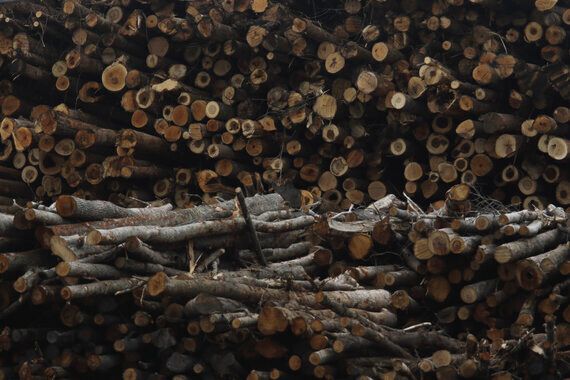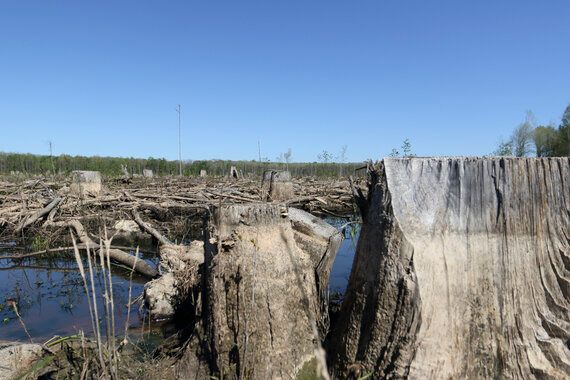New statistics released by the UK Government show that almost one third of our renewable electricity now comes, at least in part, from burning trees. Reading these new numbers, I was transported back to a trip I took in 2016.
Only just over a year ago I was staring out of a car window at dogwood trees along the interstates of North Carolina. They were just coming into bloom, their tiny white flowers brightening the vast six-lane highways.
I was on a trip coordinated by the aptly named Dogwood Alliance, a group dedicated to the preservation of hardwood and wetland forests in the southeast US. These forests are filled with decades-old, majestic trees, the older cousins of the interstate dogwoods I was gazing at. Our journey, in boat and in typically American air-conditioned and tinted window people carrier, took us along the roads and rivers of this part of the country.
Even our friends from Dogwood Alliance were awestruck by some of the wildlife we saw. Turkey vultures were everywhere. And I got the chance to see a bird I have wanted to see all my life - the bald eagle. These magnificent forests magnificent have recently been declared the world's 36th global biodiversity hotspot, joining the ranks of Indo-Burma's rainforests and the cactus scrublands of the Caribbean.

A bald eagle circles over the Roanoke River, North Carolina. Credit: Matt Adam Williams
But not far from the forests, we saw a very different sight, one that most people probably have no idea of: stacks of logs piled high and stretching as far as the eye could see, waiting to be turned into wood pellets. We also saw the clearcuts, huge scars in the landscape where beautiful wetland forests had been levelled to the ground.
Dogwood Alliance have traced this destruction (by covertly following logging trucks) directly to the nearby wood pellet mills. The clearcuts are like nothing I've ever seen in Europe; the only thing that compares in my mind is the vast deforestation, such as you may have seen in footage of the destruction of the Amazon.

Logs stacked at the Ahoskie wood pellet plant, North Carolina, which ships pellets to the UK to be burned for energy. Credit: Matt Adam Williams
We weren't the only ones who had been drawn here by the lush forests: others have come here in a 'gold rush' for the trees themselves. The EU's laudable push for renewable energy has spawned a brand new industry: burning trees for electricity. This is now big business thanks to the subsidies handed out. Trees are, by some standards, the new coal.
Governments have allowed something called bioenergy to be classified as a renewable energy. This means using organic material (everything from palm oil to sewage sludge to wood) to generate heat and electricity.
This has resulted in many companies seeking out huge supplies of timber as a cheap source of fuel. The UK now imports millions of tonnes of wood pellets every year to burn in our power stations. This comes, in no small part, from what you or I would call "whole trees" (although energy companies often like to find confusing terms like 'other low grade wood' for them). The largest supplier is the US.
Even worse, UK companies that get paid for using trees to produce energy are allowed to assume that this activity is 'zero carbon'. So they can make a fast buck getting renewable energy subsidies for an activity that is extremely bad for the climate.
The reason that burning trees is assumed to be zero carbon is two-fold: the perception is that the emissions will be quickly recaptured by the regrowth of trees; the technical reason is that it's assumed the emissions will be properly accounted for by the US, when it accounts for emissions from land use.
Both of these assumptions are completely wrong. The US doesn't currently account for any of its land use emissions, as it's not part of the Kyoto Protocol: so no one is counting these emissions at all. Perhaps this wouldn't matter so much if the emissions were small. But they're not. Science produced by the UK's former Department of Energy and Climate Change (among many other studies) showed that using these kinds of materials could be many times worse for the climate than coal (this is because wood is far less energy-dense per unit than fossil fuels are and it can take decades or longer for the forests to regrow).
Burning trees to produce electricity is making climate change far worse, not better.

A clearcut near the Roanoke River in North Carolina that Dogwood Alliance suspect is linked to wood pellets. Credit: Matt Adam Williams
These forests are a crucial line of defence against extreme weather events, like increasingly frequent and intense hurricanes that hit the southeast US annually. But perhaps the most important role that they play is that they store huge amounts of carbon. Demolishing enormous reservoirs of carbon, which are also lush habitats for incredible wildlife, seems as far from an environmental solution as you can imagine (and Bill McKibben agrees). And yet governments are handing out cash left, right and centre to companies undertaking this.
Chopping down and setting fire to our forests in order to tackle to climate change is the epitome of trying to dig ourselves out of a hole. If I return to North Carolina I hope that the forests will still be standing strong, with vultures and eagles circling overhead
